By Eric Kramer — Ambitious plans have a way of falling through. Work gets in the way, resolve weakens, and friends bail. But occasionally the stars align and a great idea materializes, and what started out as a casual discussion bloomed into a full-on road trip to Squamish, British Columbia with seven friends.
One might wonder what would possess someone to drive sixteen hours to ride bikes when we have so many good trails right here in Utah, but once you’ve ridden Jacob’s Ladder and Rush for the umpteenth time, you begin to long for something completely different. Plus, the stories of Squamish and Whistler B.C. are legendary. Loamy dirt that never gets muddy or dusty, granite peaks adorned in glaciers in all direction, and some of the steepest and most challenging terrain in the world. We had to see it for ourselves.
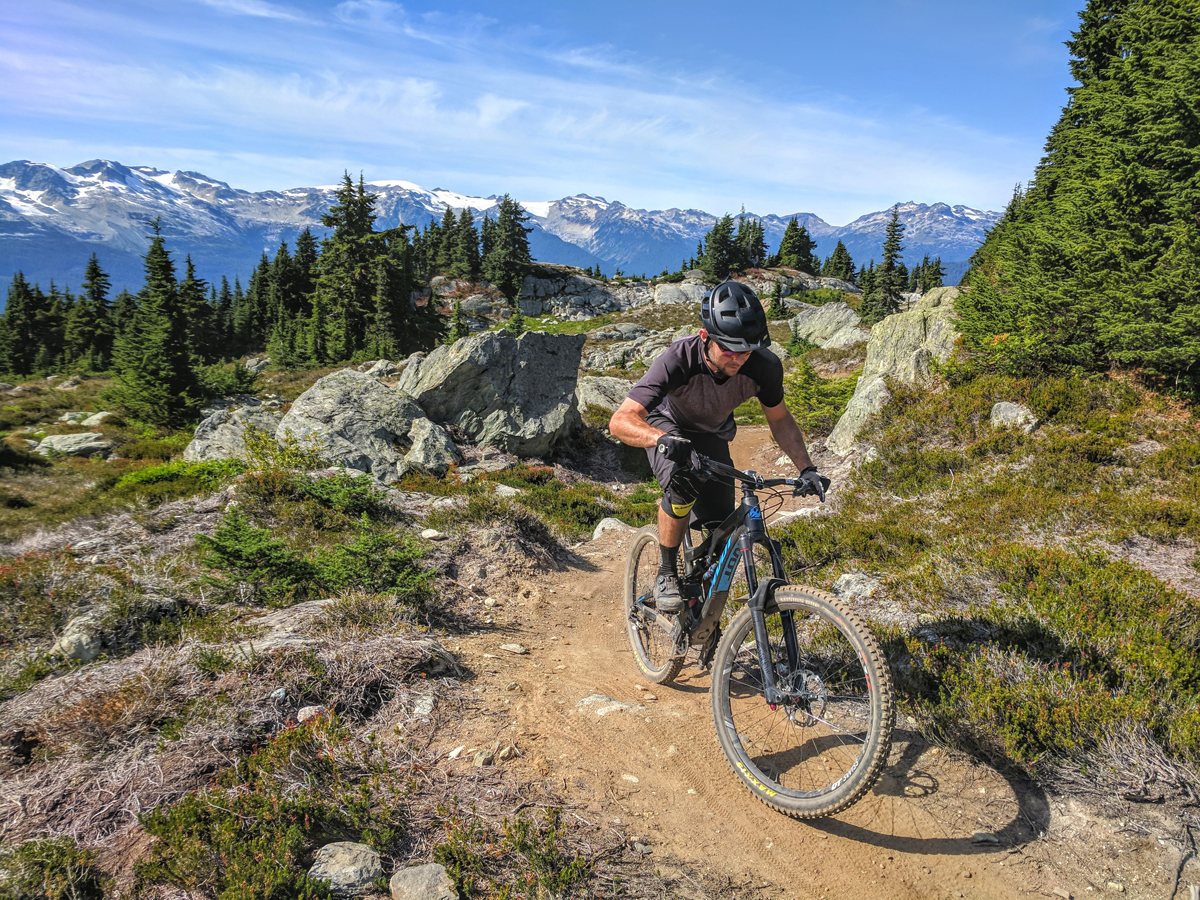
After doing some research we determined that June and September are the best times of year to go because there’s more moisture to keep the trail conditions perfect; we opted for September because the high terrain would be open. The weeks leading up to our departure were worrying, though. Forest fires ravaged the Pacific Northwest (PNW), and reports were that Whistler was blown-out, dusty dry and that the air was full of smoke. Then the Deer Valley Enduro Cup ran two weeks before we planned to leave, and we told everyone “Don’t get hurt! Squamish!” at which point Steve proceeded to knock himself out at the bottom of NCS (the only upside of which was briefly forgetting Trump was president), and Sam hurt his shoulder re-running the same stage after Steve’s crash halted the race.
Two weeks later, though, Steve was given the clear to ride again, and the forecast was looking favorable with rain in B.C., so Steve, Bryson and I loaded up Jon’s truck with our bikes, made a final stop at Go-Ride for last minute supplies, and hit the road. Sam, a confirmed “van guy,” would drive up in his van, and Piper and Brett would both be flying in a couple days later. The drive through Idaho, Oregon, and Washington was unsettling. A thick haze of smoke permeated the air, and the sun shown red during the midday hours. But as we reached Bellingham, Washington a sweet, light rain was falling, clearing the air and perfecting the dirt, so we decided to pull off the highway and ride bikes. Within the first few feet of trail at Galbraith Mountain we were all ecstatic to be riding in the PNW; it was raining yet the dirt was hard and tacky, the trails were brilliantly sculpted for flow and speed but with enough intervals of rooty, rocky tech to keep you on your toes. Steve, recovering from a concussion, hadn’t been on a bike for two weeks since the crash, and Piper, his wife, instructed him not to “send it.” But when you’re feeling the flow, you can’t help but send it, and that’s exactly we did.
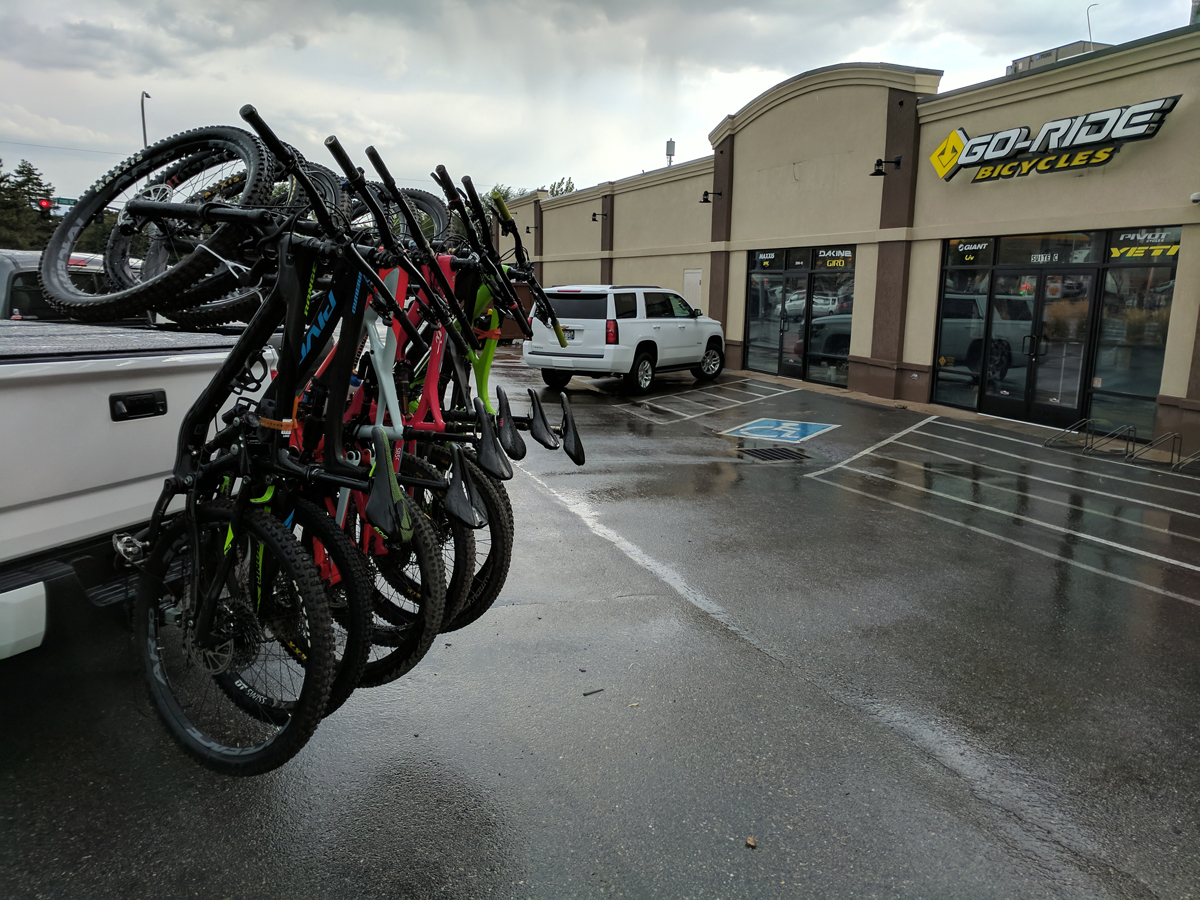
At the bottom of our last descent, the clouds cleared and the sun came out revealing pine-covered mountains rising out of the mist and Bellingham Bay in the distance. This was going to be a good trip. A few hours later we pulled into our Airbnb in Squamish, a cozy place with coffee and bike shops within walking distance, and some of Squamish’s best trails within riding distance. Heading into the Squamish forest for the first time was like entering the forests of Endor, so green with moss and fern and still glistening from the recent rain. We started with a lap down Half Nelson, a fun flow trail that was a little worse for wear after a long dry summer. Nevertheless we all high fived at the bottom, blown away by the quality of the trail.
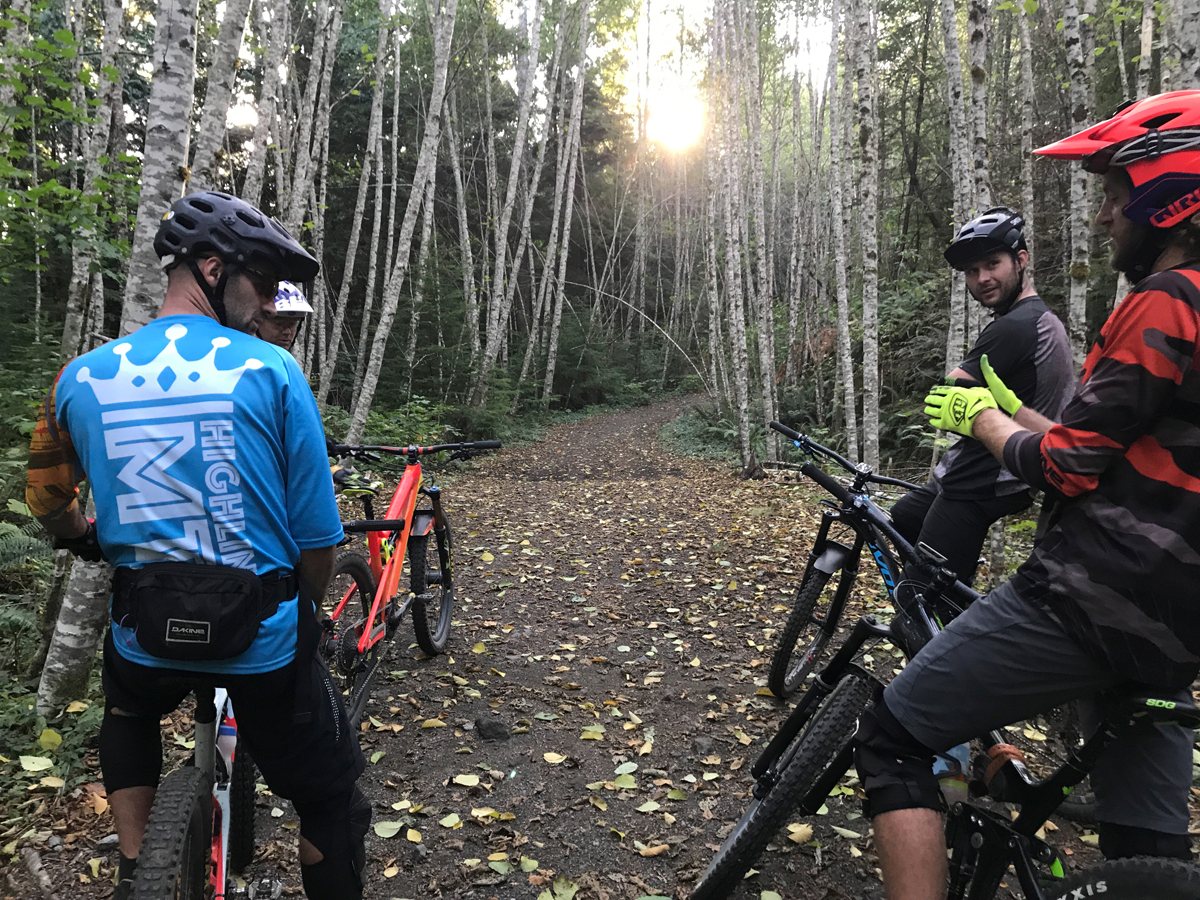
Our real initiation happened later that afternoon when we met up with Sam’s buddy, “Angry Jon,” an American expat who somehow managed to get himself a job at the one tiny college in a town known the world over for incredible biking and skiing. Word was Angry Jon had only skipped riding seven days that entire year, and those were due to his bike being in the shop. He doesn‘t Strava or Instagram; for him riding a bike isn’t about getting likes or KOMs, but is as core to his existence as breathing. I imagine he devoted himself to his scholarly field with the same intensity, landing him a great job in one of the most coveted places you could imagine for a mountain biker.
We met up with Angry Jon and his buddy Tim and loaded our bikes into the back of their decades old trucks into homemade racks made from 2x4s. Blasting up gravel roads at ludicrous speeds, my bike nearly fell out of the rack and off the truck, so Angry Jon had to gun it even more to catch up with Tim so we could yell at him to stop. The trailhead was nothing more than an easily-missed entrance into the thick forest. This trail is not on Trailforks, and it probably didn’t even exist a few months earlier. Dropping in we discovered a whole new definition of steep. Your tires are desperately searching for grip in the soft loam, brakes begin to fade, and you realize that gravity is no longer your friend but your constant enemy who would rather see you lose control and tumble down the mountain.
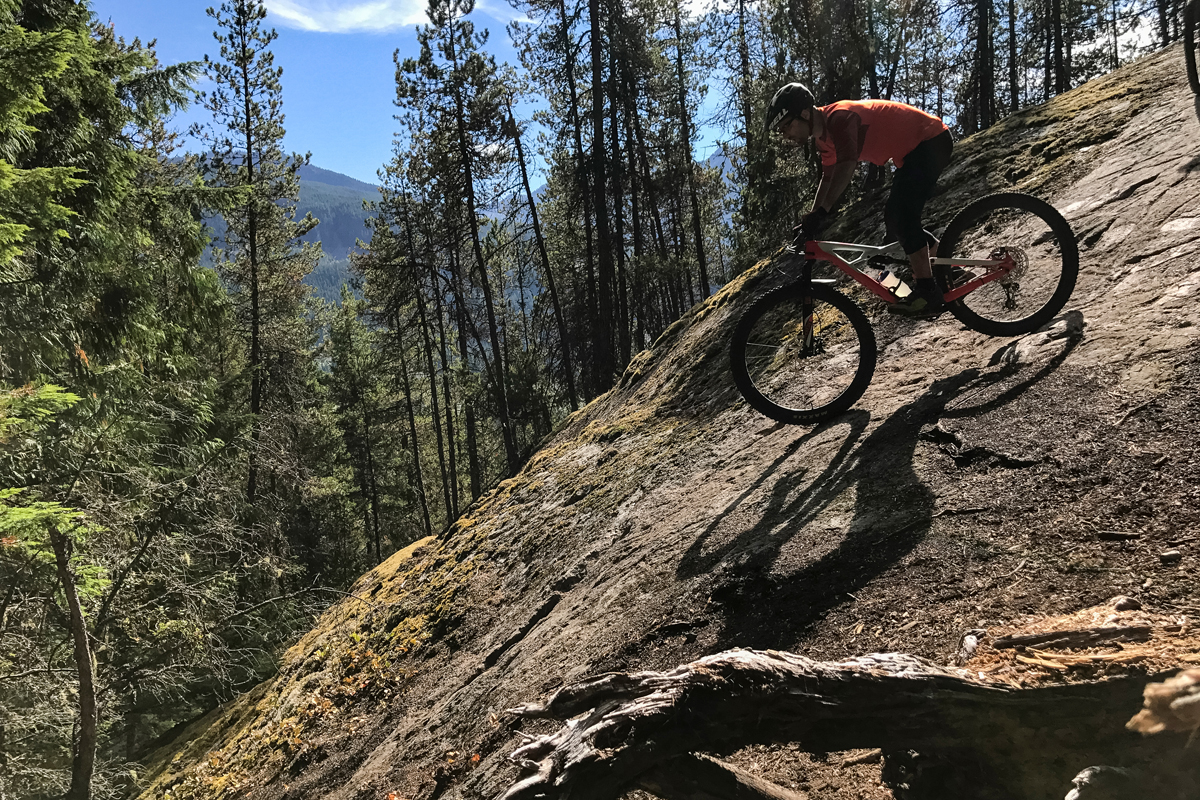
And then there were the granite slabs. The closest thing we have to granite slabs is the sandstone terrain in Moab, yet these are more intimidating than anything I’ve seen there. They tend to be steeper and longer, but you have more grip. They’re usually incorporated into the trail in a way that there’s no ride-around. Angry Jon did his best to prepare us newbs for this novel surface by telling us to grab as much front brake as our forearms could muster, and try not to let the back wheel skid. This is counter-intuitive to most riders who’ve been told over and over that too much front brake results in OTBs. Yet the approach worked: our tires held fast despite the fact that I squeezed my front brake so hard my forearms started to cramp.
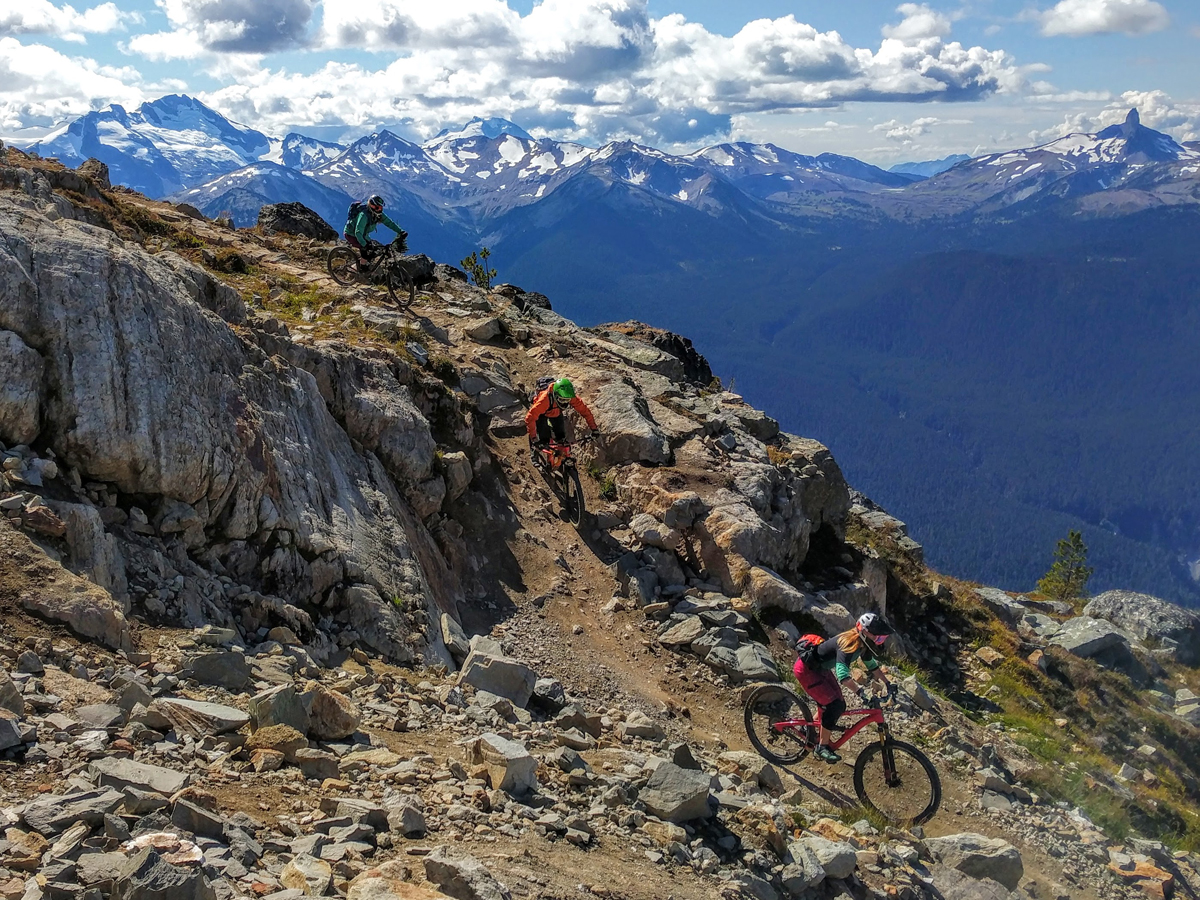
It doesn’t take long in Squamish to find your limits, though. Angry Jon warned us that a particular chute had taken out many of the best local riders, but I was feeling confident and decided to give it a go. Within seconds I was over the bars going end-over-end while my bike tomahawk-ed down the trail. Later on, after too long a break and idle chit-chat, Sam coined the phrase “less talk more tomahawk-ing!”
For most of my 25+ years of riding, I’ve relied on a good dose of speed to carry me through sketchy sections of trail. But in Squamish the terrain is so steep and unforgiving that the smarter approach is to go in slow with as much control as possible. You have to alter your thinking and turn off the Strava in your brain and realize that going fast isn’t the only measure of riding ability. When it comes to difficulty, every trail in B.C. is rated below an equivalent trail in Utah, so a “blue” trail in B.C. is similar in difficulty to a “black” trail in Utah, and a double black trail in Squamish is more difficult than just about anything we have here. Forget about going fast — riding and surviving the trails here is the ultimate rush.
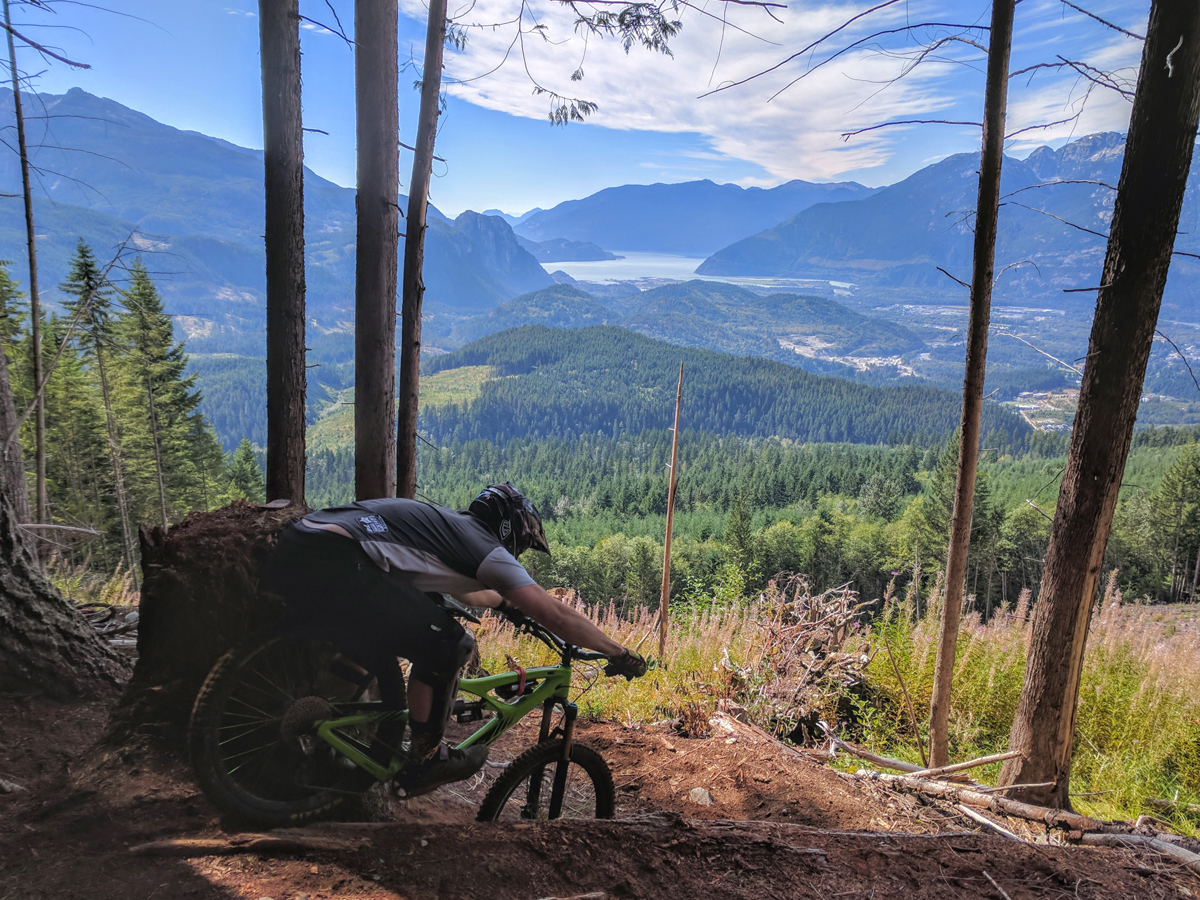
And the steepness doesn’t just apply to the descents. The Canadians are a hardy people and they don’t worry themselves with manageable grades for mountain bikes. Straight up the mountain is the most direct route, so that’s the one they take. It was obvious that Angry Jon was far better at technical downhill riding than us, but he lives at sea level. For our next ride with him there would be no shuttling and surely we would redeem ourselves by showing him how riders from the high elevation state of Utah can climb. When we met up with Angry Jon and his buddy Phil for another ride, both of them had their jerseys off with their helmets strapped to their bars. We were all thinking how undignified that was, but half way into the climb we started to understand. We kept up pretty well until about half way up an old mining road, when we hit a wall. The road went straight up and the surface was full of loose rocks. I was determined not to walk, but after spinning out with my heartrate well beyond the lactic threshold, I gave up and watched Angry Jon and Phil ride away from me. When I finally made it to the top, I was so drenched with sweat from the deceptively humid air that even the contents of my hip pack were soaked. To add a little salt to my wounded ego, Angry Jon remarked that when you see the locals doing something, you should probably do it too. Yeah, he was probably right on this one.
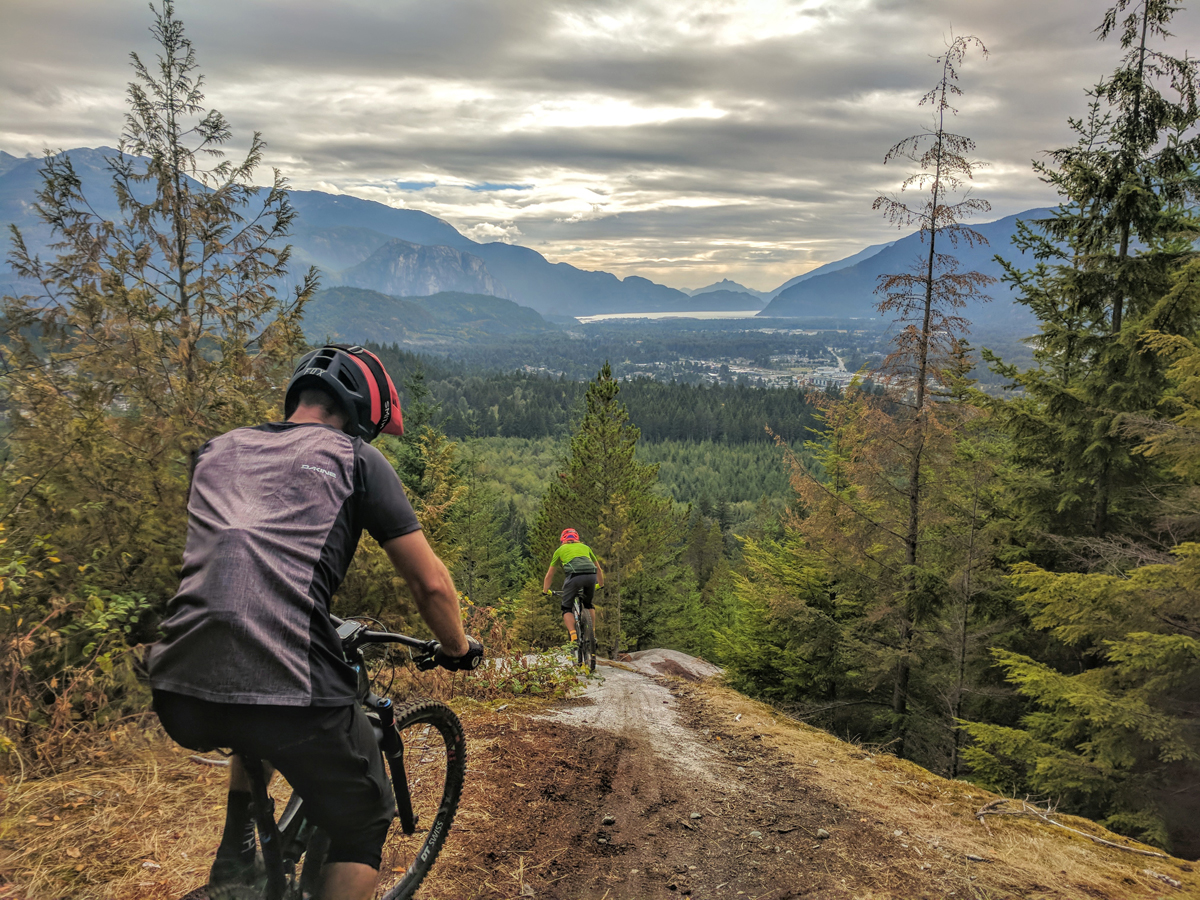
As the week progressed we gained confidence, but our bodies struggled to adapt to the fact that we were doing two big rides every day. We kept it up, though, and by mid-week we rode Top of the World in Whistler, followed by Khyber, Middle of Nowhere, Kashmir, and Kush. This was the most unrelenting technical terrain I have ever ridden with mile after mile of steep, rooty drops and thousands of feet of descending. My arms were failing me and with every g-out my chest came closer to colliding with my handlebars. So the next day we only did one easy ride and spent the rest of the day at a mountain lake cliff diving, swimming, and relaxing with some cold beers.
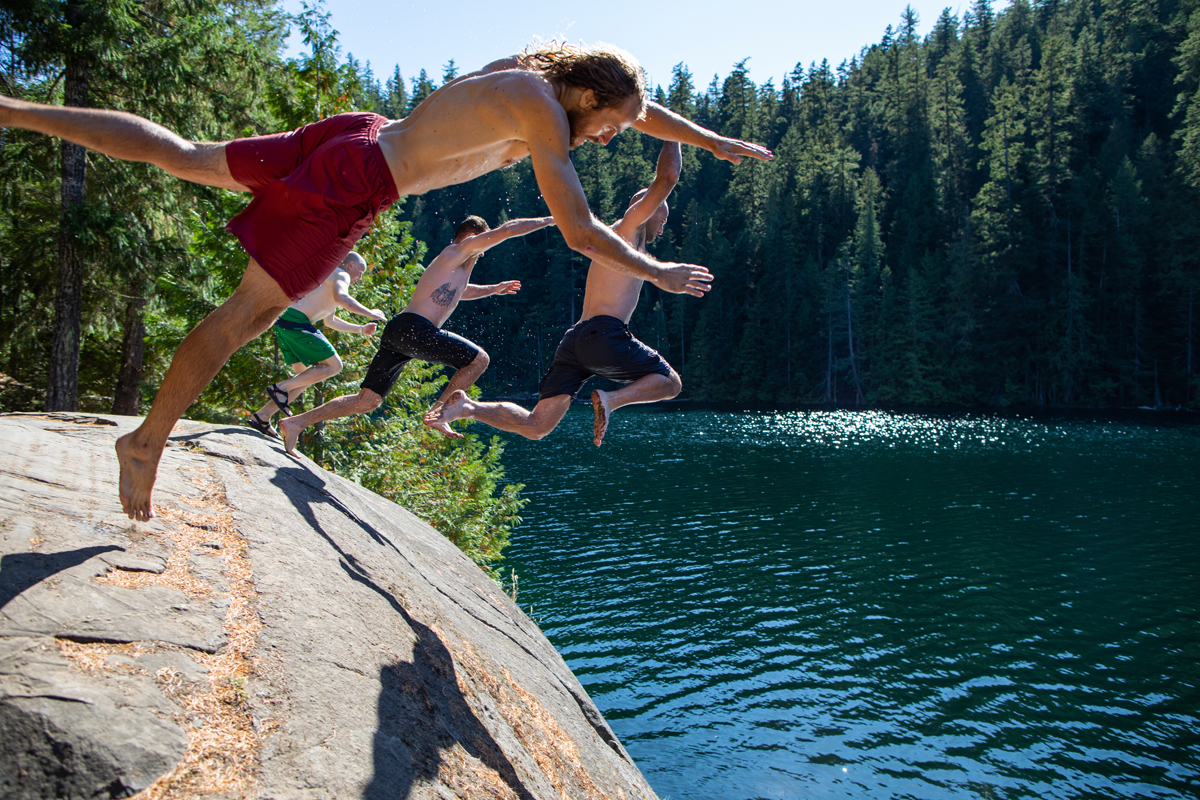
The rest was much needed because the next morning we would ride Into the Mystic and Lord of the Squirrels, a 22-mile, 4500-foot climb into the high alpine of B.C. It’s easy to mistake Into the Mystic as the B.C. equivalent of Park City’s Armstrong trail (after all it’s a similar machine cut wide format trail), but I was quickly reminded as I Eagle’d out into my easiest gear: everything in B.C. is a lot steeper. But the effort was worth it as a couple hours later we entered the most magical zone of granite, glistening alpine lakes and a 360-degree panorama of distant peaks and glaciers. The Lord of the Squirrels descent is only rated as a blue trail, but in Utah it would easily be a black or double black. It’s fairly technical, and dropping 3000 feet in four miles resulted in jello legs at the bottom. From there we decided to be prudent and take the easiest way back, but the double black “AC/DC” trail looked like too much fun, so we dropped it and found even more steep terrain with rock slabs.
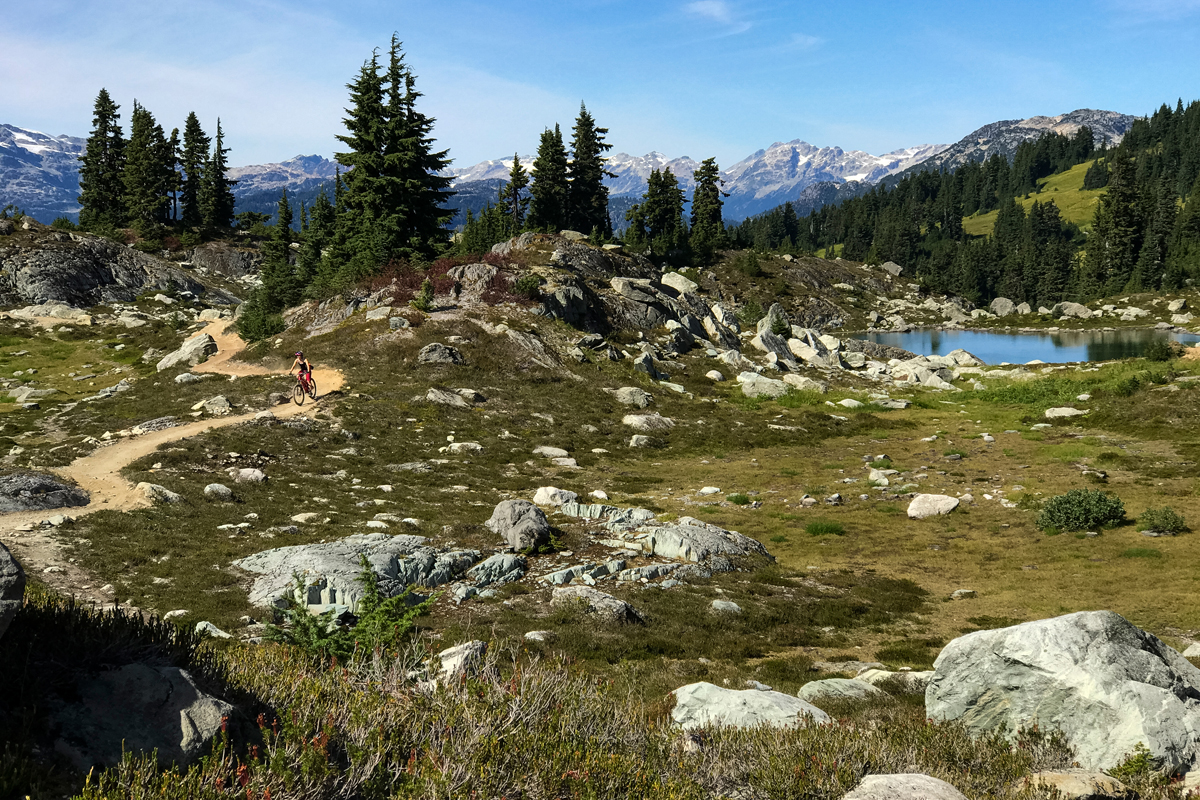
After years of riding the hardest trails in Utah, I started to feel pretty confident in my abilities, but Squamish was an awakening to just how demanding trails can be. We all came back sore and scratched up but in one piece, (although Brett the bee harasser came back with about a dozen bee stings) and with the most satisfying feeling that we went to Squamish and Whistler and gave it our all. The steepness–both up and down, the soft loamy dirt, roots, and rock slabs are what make B.C. trails unique, but we actually have pockets of terrain in Utah that share a lot of these features, and I hope we can learn from the British Columbians and emulate their trails here. In Utah it seems like most of the trails are machine-cut sidewalks, but in B.C. even the XC trails are technical, and the number of double black trails that can work you is mind-blowing. We tried to ride as much as we could, but we barely scratched the surface. And that’s why we’ll be going back this summer, with a little more experience and confidence to take it up to the next level. Riding in B.C. is humbling. There are so many trails and so many of them are harder than anything we have here, but spending time there will make you a better rider, and I came back to Utah with more confidence to ride trails and features that used to scare me.
Tips for planning a trip to BC
- Do a thorough tune-up on your bike beforehand and replace anything worn past 50% and put some fresh rubber on for maximum grip
- Replace your cables and housing as the B.C. moisture will bond with the months of built-up Utah dust and ruin your shifting
- Bleed your brakes–you’ll want them to be performing at their best on the steeps
- Take as many spares (derailleur hangers, tires, cables, etc.) as you can as everything is a lot more expensive up there
- Take a bike stand and tools if possible, because you’ll end up doing a lot of work on your bike
- Train for it like you are training for a week long mtb race–you’ll want to ride as much as you possibly can, and your body will be the limiting factor
- Take the biggest bike that still climbs decently, as everything is steep and gnarly and a slack bike with big, grippy tires will make it more rideable; it’s also not a bad idea to go with a smaller chainring because the climbs are so steep
- Get as much local knowledge as you can: Angry Jon took us on trails we never would have found and gave us advice on which trails ride and in what order and direction to ride them.

